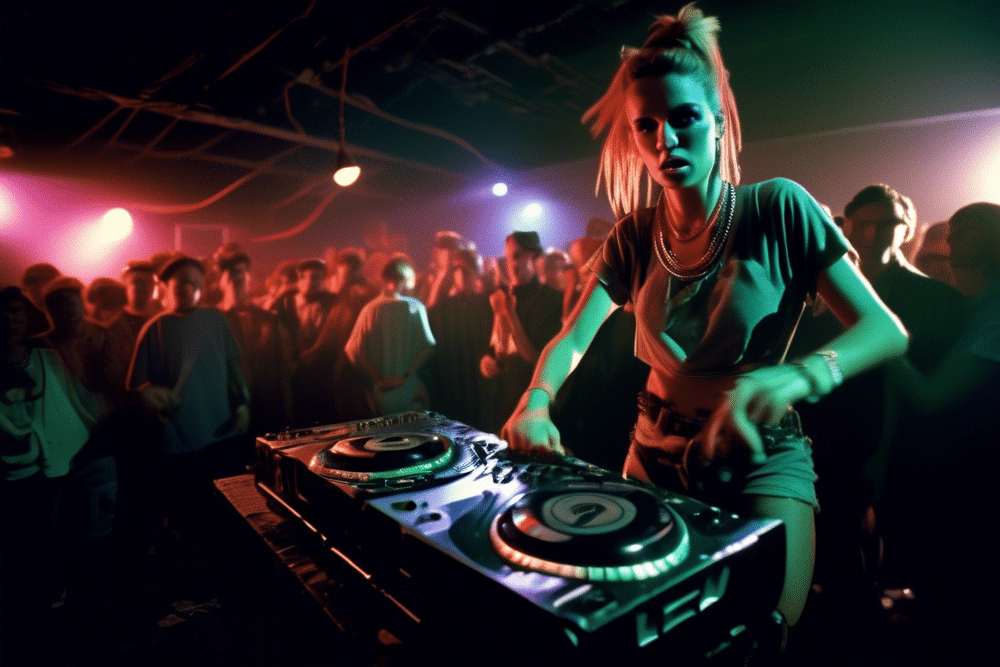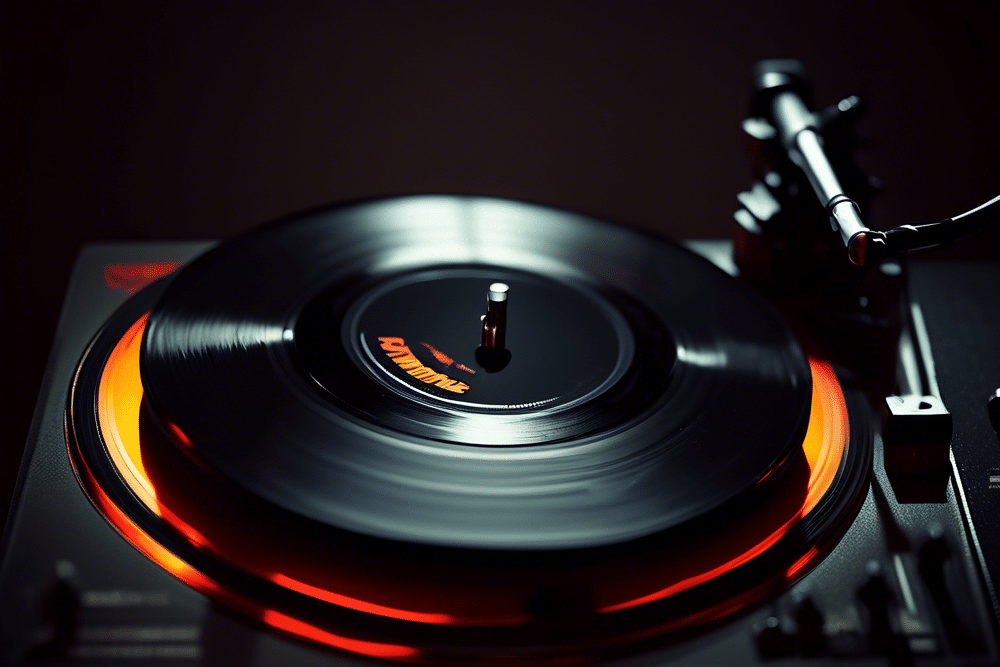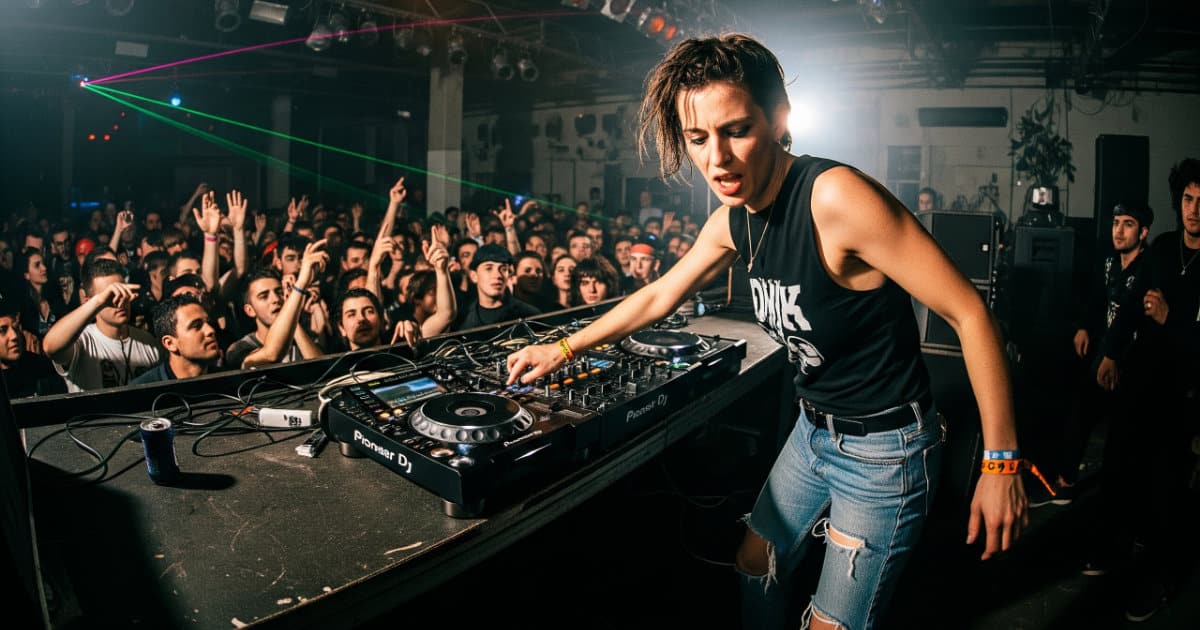Estimated reading time: 13 minutes
In the male-dominated world of hard dance music, Dana van Dreven emerged as a trailblazing force. Born in Amsterdam in 1974, she transformed from an unexpected DJ filling in at a party to becoming the most popular female DJ in hardcore and hardstyle genres. Her journey from playing gabber music in 1993 to achieving a top ranking in Mixmag’s prestigious hard dance DJs list speaks volumes about her exceptional talent and determination. This evolution from the raw sounds of what is defined as Gabber music to a more refined style highlights a key trait she shares with many of the most influential Hardstyle DJs today.
Behind the pulsating beats and energetic performances lies a story of remarkable resilience. In 2010, Lady Dana faced a devastating series of health challenges—burnout, melanoma, and debilitating nerve damage—that forced her into a lengthy hiatus. Yet, in true pioneer fashion, she staged an inspirational comeback after two and a half years, performing at Thunderdome primarily using one arm. From her early days at Universal Dance in Amsterdam to founding her own record label Danamite, Dana’s career illuminates both her musical genius and her unwavering spirit in overcoming personal obstacles.
Table of contents
The Rise of DJ Lady Dana
A. Early beginnings in 1993 with gabber music
The hardcore scene was exploding in the Netherlands when Dana Ploeger stepped behind the decks in 1993. This vibrant era was foundational for the entire genre, and understanding the roots of Hardcore Techno is essential to appreciate its modern forms. Just a teenager with fire in her eyes and beats in her soul, she dove headfirst into the gabber scene when it was still raw, underground, and predominantly male.
What made Dana stand out wasn’t just that she was one of the few women in the scene. It was her uncompromising style and technical skill that turned heads. While others were still figuring out their sound, Dana already knew exactly what she wanted: hard, fast, and unforgiving beats that could make warehouse walls shake.
B. Breakthrough at Universal Dance in Amsterdam
Amsterdam’s Universal Dance became the stage for Dana’s meteoric rise. In the pulsing heart of the city’s electronic scene, she didn’t just play sets – she delivered experiences that left crowds gasping for breath and begging for more.
The Universal Dance residency transformed her from promising talent to undeniable force. Week after week, the venue packed with fans who came specifically to witness the magic Dana created. Her name on the lineup wasn’t just another booking – it became a guarantee of thunderous, boundary-pushing performances.
C. Expansion to performances across the Netherlands and Europe
Soon, Dana’s calendar filled with gigs across every major Dutch city. Then came Germany. Belgium. Italy. The Lady Dana phenomenon couldn’t be contained.
Festival organizers scrambled to book her as word spread about this fearless Dutch DJ who could command crowds of thousands with her relentless energy. From Thunderdome to Mystery Land, Dana conquered the biggest stages in hardcore music. These events are now legendary, setting the standard for the best Hardstyle festivals around the world that fans flock to every year.
D. Work at Outland Records
Behind the booth, Dana proved equally formidable in the studio. Her role at Outland Records gave her platform to shape hardcore’s future through both her own productions and discovering new talent.
At Outland, she wasn’t just releasing tracks – she was defining what hardcore could be. Her productions featured that signature Dana sound: technically flawless, brutally energetic, yet surprisingly musical. The label became synonymous with quality, largely thanks to Dana’s golden ear and unwavering standards.

Musical Career and Achievements
A. Prominence in hardstyle and hardcore genres
DJ Lady Dana isn’t just any artist in the electronic scene – she’s a pioneer who shaped the hardcore and hardstyle landscape when these genres were still finding their footing. Since the early ’90s, she’s been dropping tracks that make crowds go wild, cementing her reputation as one of the most influential figures in hard dance music.
Her signature sound blends relentless beats with unexpected melodic twists that hit you right in the chest. When Lady Dana takes control of the decks, something magical happens – even the most skeptical listeners find themselves drawn into her high-energy world.
B. Recognition as the leading female DJ in hard dance
In a male-dominated industry, Dana didn’t just participate – she dominated. She broke through glass ceilings and stereotypes to become the undisputed queen of hard dance. What makes her stand out isn’t just her gender but her unmistakable style and technical prowess.
Many female DJs in the scene point to Lady Dana as their inspiration. She opened doors that were previously closed and showed that talent transcends gender in the DJ booth.
C. Ranking in Mixmag’s top 100 hard dance DJs
Her technical skills and fan base earned her consistent spots in Mixmag’s prestigious top 100 hard dance DJs list for multiple years running. This isn’t just industry recognition – it’s proof of her enduring impact and relevance in a constantly evolving scene.
D. Various aliases including D Lerius and DJ Dana
Like many electronic artists, Dana has explored different sounds under various aliases. As D Lerius, she ventured into more experimental territory, while as DJ Dana she delivered pure, unadulterated hardcore. Each persona allowed her to explore different facets of her musical creativity while maintaining the intense energy she’s known for.

Discography and Collaborations
A. Singles, compilations, and DJ mixes (1996-2009)
Lady Dana’s early discography reads like a history book of hardcore techno. Starting in 1996, she dropped singles that quickly became underground classics. Her raw energy translated perfectly onto vinyl, with tracks like “Angerfist” and “Necrophobia” defining the aggressive edge of the genre.
Between 1996 and 2009, Dana released over 50 singles and appeared on countless compilations that spread hardcore techno worldwide. Her DJ mixes from this period, particularly “Megarave” and “Thunderdome” series, showcased her unmatched ability to read a crowd and build tension through expertly crafted sets. Many tracks featured in these iconic sets are now considered classics and would easily fit into a list of the 32 best Hardstyle songs of all time.
What made Dana stand out wasn’t just her technical skill but her signature sound—recognizable within seconds of a track starting.
B. Released works through Masters Of Hardcore and The Third Movement
Dana’s relationship with legendary labels Masters Of Hardcore and The Third Movement helped cement her status as hardcore royalty. Her influential role during this time was a critical element in the overall history of what is Hardstyle music today. Through MOH, she released some of her most iconic work, including “Diss Reaction” and collaborations with other genre heavyweights.
The Third Movement became a creative home where Dana could push boundaries. Her releases on this label showed her evolution as a producer, incorporating more complex structures while maintaining the raw power fans loved.
These partnerships weren’t just business arrangements—they were artistic collaborations that shaped the sound of hardcore for a generation.
C. Creation of her own record label, Danamite
Taking control of her artistic vision, Dana launched Danamite Records, giving her complete freedom over her sound and image. This bold move allowed her to nurture emerging talent while continuing to release her own productions on her terms.
Danamite quickly gained respect for its uncompromising quality and authentic hardcore aesthetic. The label became known for limited pressing vinyl releases that collectors scrambled to get their hands on.
Running Danamite showcased Dana’s business acumen alongside her creative talents—proof that women could dominate every aspect of the electronic music industry.

D. Formats spanning vinyl, CDs, and digital releases
Dana’s discography spans the evolution of music formats. Her early work lives primarily on vinyl—those 12-inch records that DJs would carry in heavy crates to clubs across Europe.
As technology evolved, so did Dana’s release strategy. Her mixes and compilations found homes on CDs, reaching wider audiences during the format’s heyday. When digital distribution emerged, Dana adapted again, ensuring her catalog remained accessible to new generations.
Despite embracing digital platforms, she maintained her connection to vinyl, understanding its importance to hardcore culture and sound quality. This balance between tradition and innovation reflects Dana’s approach to her entire career—respecting roots while constantly moving forward.
Health Challenges and Comeback
Career hiatus beginning in 2010
2010 marked a turning point for Lady Dana. After dominating the hardcore and hardstyle scene for years, she suddenly stepped away from the decks. Fans were shocked – she’d been a fixture at major festivals and clubs across Europe, her distinctive sound drawing massive crowds wherever she performed.
The dance music world kept spinning, but Lady Dana’s absence left a noticeable gap. No new tracks, no festival appearances, no club nights. For someone who’d been a constant presence since the early 90s, this sudden disappearance raised questions and concern among her loyal followers.
Battle with burnout, melanoma, and nerve damage
Behind the scenes, Dana was fighting multiple battles. The relentless touring schedule had led to severe burnout – a common but rarely discussed issue in DJ culture. Then came a devastating melanoma diagnosis, requiring intensive treatment.
As if that wasn’t enough, she developed serious nerve damage that affected her mobility. For a DJ whose physical presence and energy behind the decks was legendary, this was particularly cruel. Many wondered if we’d ever see her perform again.
Remarkable return after two and a half years
After nearly three years of silence, Lady Dana made her comeback. The electronic music scene had evolved, but her reputation remained intact. Her return wasn’t just impressive because she came back – it was how she did it.
Performance at Thunderdome festival with limited mobility
Talk about determination! Despite still dealing with mobility limitations, Dana took to the stage at Thunderdome, one of the most physically demanding festival environments. She performed seated for portions of her set, yet delivered with the same intensity that made her famous.
The crowd’s reaction? Pure electricity. They weren’t just witnessing a set; they were witnessing triumph over incredible adversity.

Cultural Impact and Legacy
A. Breaking barriers as a female artist in a male-dominated industry
Talk about swimming against the current. DJ Lady Dana didn’t just enter the male-dominated electronic music scene – she crashed through its doors and made everyone take notice. When she first grabbed those turntables in the early 90s, female DJs were as rare as calm moments in a hardcore set.
The hard dance scene was practically a boys’ club, with technical skills and aggression often falsely labeled as “male traits.” Dana flipped this narrative on its head, matching – and frequently exceeding – the intensity and technical prowess of her male counterparts.
What’s truly remarkable wasn’t just that she survived in this environment, but that she became one of its defining voices. She didn’t water down her sound to fit expectations; instead, she cranked up the BPMs and let her hardcore beats speak for themselves.
B. Contributions to Dutch hard dance scene evolution
The Dutch hard dance landscape would look completely different without Lady Dana’s influence. She was there at the beginning, helping to craft what would eventually evolve into the hardstyle and hardcore scenes that now draw tens of thousands to festivals worldwide. For those inspired by her journey to create their own tracks, learning the process of making Hardstyle music is a great starting point, and having the right Hardstyle FX sounds is crucial.
Dana’s mixing technique – seamlessly blending relentless beats with just enough melody to create emotional resonance – became a blueprint for generations of artists. Her sets at legendary venues like Thunderdome didn’t just entertain crowds; they helped define an entire musical movement.
Her willingness to experiment pushed the genre forward. While some artists found a comfortable sound and stuck with it, Dana continually explored the edges of hard dance, incorporating elements that kept her music fresh while maintaining its raw energy.
C. Resilience as a defining characteristic of her career
If there’s one word that captures DJ Lady Dana’s journey, it’s resilience. Her career has been a masterclass in bouncing back from setbacks that would have sidelined lesser artists.
The electronic music industry is notoriously fickle, with trends and sounds shifting constantly. Dana navigated these changes with remarkable adaptability, remaining relevant across multiple decades and evolutionary stages of hard dance music.
Her personal struggles, particularly with health issues, could have easily ended her career. Instead, they became part of her story of determination. When she returned to performing after health-related breaks, crowds didn’t just welcome her back – they erupted.
D. Influence on future generations of electronic music artists
Dana didn’t just open doors for female DJs; she blew them clean off their hinges. Today’s diverse electronic music landscape owes a debt to pioneers like her who proved talent transcends gender.
Young female artists in particular point to Lady Dana as proof that they belong behind the decks. Her success showed them they could pursue their passion without compromising their artistic vision or identity.
But her influence extends beyond gender barriers. Any artist who values authenticity and artistic integrity can find inspiration in how Dana stayed true to her sound while continuously evolving. Her career demonstrates that commercial success and artistic credibility aren’t mutually exclusive – a lesson that resonates with DJs of all backgrounds.
Video: DJ Lady Dana live in the Mix 💯 Nederland
Conclusion
DJ Lady Dana’s journey through the electronic music scene stands as a powerful testament to resilience and artistic passion. From her groundbreaking start in 1993 playing gabber music to becoming one of the most influential female figures in hardstyle and hardcore, Dana van Dreven broke barriers in a male-dominated industry. Her impressive discography, collaborations, and recognition in rankings like Mixmag’s top 100 hard dance DJs cemented her place in electronic music history. Despite facing severe health challenges including burnout, melanoma, and nerve damage that forced a hiatus in 2010, her remarkable comeback—performing at Thunderdome using primarily one arm—demonstrates her extraordinary determination.
Dana’s legacy extends beyond her musical achievements. Through her record label Danamite and her pioneering presence as a female DJ in hard dance events, she has inspired countless artists who followed in her footsteps. Her story reminds us that true artists aren’t defined solely by their success but by their ability to overcome adversity and continue pursuing their passion against all odds. DJ Lady Dana didn’t just contribute to a music genre—she helped shape its evolution while proving that talent and perseverance transcend all boundaries.
Related Posts
- The Best Hardstyle Artists Shaping the Genre’s Future
- The Prophet: From Hip Hop Beginnings to Hardstyle Legend and His Enduring Legacy
- DJ Pavo: The Dutch Master of Hard Dance
- DJ Isaac: A Deep Dive into the Hardstyle Legend’s Music, Career, and Influence
- Phuture Noize: The Story, Sound, and Legacy of a Modern Hardstyle Icon
- Act of Rage: Signature Kicks, Brutal Drops, and Global Hardstyle Impact
- Noisecontrollers: Signature Kicks, Emotional Melodies, and Global Impact
- Adjuzt: Unveiling the Sound and Journey of Groningen’s Rawstyle Innovator
- Gunz for Hire: How Ran-D and Adaro Defined an Era of Raw Power
- What Is Speedcore?
- Is Hardstyle EDM?
FAQs
DJ Lady Dana is considered a pioneer because she rose to prominence in the early 1990s, breaking barriers as one of the first and most successful female artists in the male-dominated genres of hardcore and hardstyle. Her technical skill and uncompromising style set a new standard and inspired future generations of female DJs.
She is most famous for her contributions to the hardcore, gabber, and hardstyle genres. She began her career in 1993 with gabber and became a leading figure as hardstyle evolved.
In 2010, DJ Lady Dana began a career hiatus to battle a series of severe health challenges, including burnout from a relentless touring schedule, a melanoma diagnosis, and debilitating nerve damage that affected her mobility.
Her comeback was remarkable because, after a two-and-a-half-year absence and despite ongoing physical limitations from nerve damage, she performed at the legendary Thunderdome festival. She delivered an intense set while primarily using only one arm, showcasing incredible resilience and determination.
Yes, she founded her own record label called Danamite. This allowed her to have complete artistic control over her music and to release tracks from other emerging talents in the hardcore scene.
